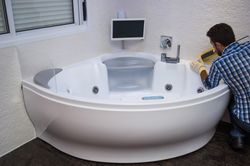FAQ About Plumbing When Remodeling a Bathroom

Remodeling a bathroom is no easy task. Whether it involves major overhaul or minor tweaks, it is still essential to have professional help to avoid common plumbing pitfalls that might arise during the project. Because the room centers around drains and water supply, bathroom remodeling projects often need a bit of guidance from a plumber. Below are a few common questions that homeowners have about upgrading their bathroom fixtures.
Common Remodeling Questions for a Plumber
Can I move the location of my bathroom fixtures?
During a bathroom remodel, you may want to relocate the tub, shower, toilet, or sink to improve the layout. It is possible, but doing so will significantly affect your existing plumbing system. It requires the installation of additional water supply pipes and sewage drains in addition to rerouting the lines to make everything work properly. A plumber will also have to consider local code requirements and room limitations, such as the bathroom’s location in the house and available crawlspace when moving plumbing.
Can I replace my tub with a shower and vice versa?
 Just as you can change the location of your fixtures, it is also possible to convert an area’s functionality. If you’ve always dreamed of a large tub or miss the ease of a standing shower, discuss the installation process with a plumber. While it is nearly always possible, it may require moving additional features to make room for a spacious tub or shower.
Just as you can change the location of your fixtures, it is also possible to convert an area’s functionality. If you’ve always dreamed of a large tub or miss the ease of a standing shower, discuss the installation process with a plumber. While it is nearly always possible, it may require moving additional features to make room for a spacious tub or shower.
What are low-flow fixtures and why install them?
When remodeling a bathroom, think about upgrading to low-flow fixtures, which can significantly reduce your water consumption. Newer toilets, showerheads, and faucets provide the same functionality but use different mechanisms to slow down water flow rate:
- Toilets: Low-flow toilets are typically designed to have two options—a half-flush for liquid wastes and a full flush for solid ones. Gravity-fed and pressure-assisted are the two types of low-flow toilets, with the former relying on gravity to push water down. The latter uses built-up air pressure in the tank to flush everything down, consuming less water in the process.
- Faucets: To reduce the flow rate in your faucets without investing in new fixtures, consider adding an aerator or restrictor to minimize water consumption. Replace old faucets that run more than 2.5 gallons per minute (GPM).
- Showerheads: Ideally, showerheads should have at least 55 pounds per square inch (psi) of water pressure. Low-flow fixtures deliver up to 80 psi but with flow rates less than 2.5 GPM, saving on utility costs. There are two kinds of low-flow showerheads: laminar-flow and aerating. Laminar-flows spray water in streams while aerating options mix water with air to create a mist-like stream.
For the best results from a bathroom remodeling project, hire a licensed plumber from Wild West Plumbing Heating & Drain Service. Serving communities in and around Flathead County, MO, their team of professionals has provided exceptional plumbing services—from leaking pipes to septic system repairs. Call (406) 752-1244 to request an estimate, and visit their website to learn more about their services.
About the Business
Have a question? Ask the experts!
Send your question

